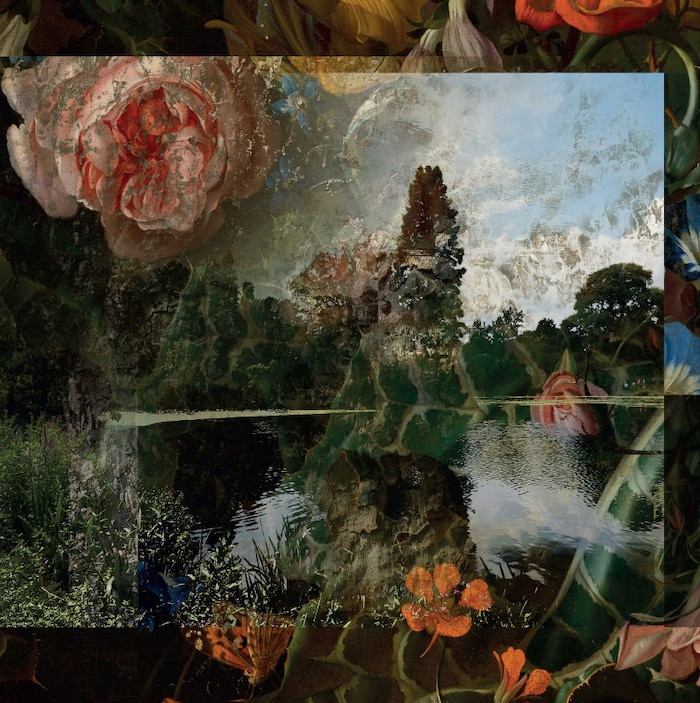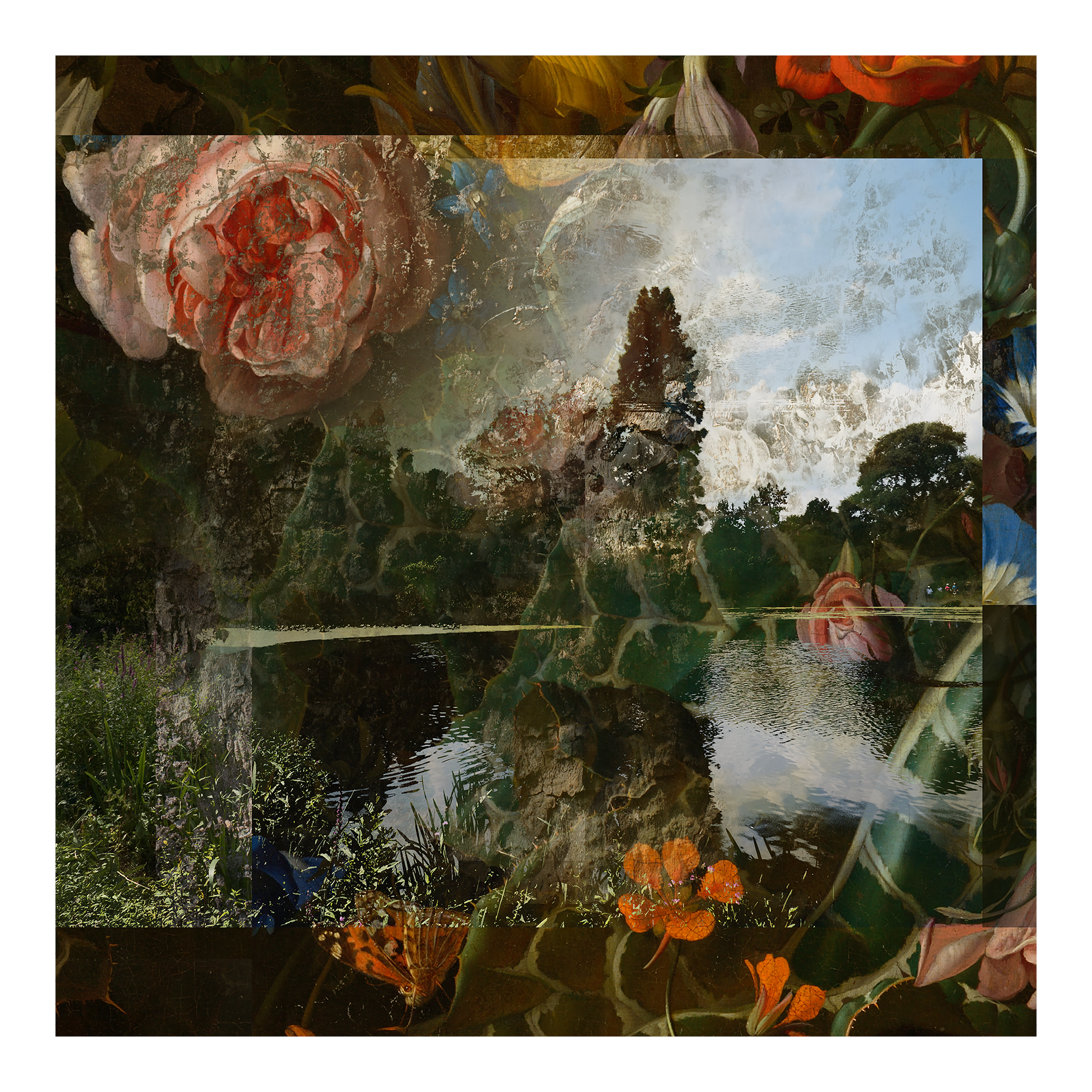The Lost World of J.G. Biberkopf
Christina Aguilera is singing the Star Spangled Banner at the 2011 Super Bowl, on YouTube. She’s introduced by a booming male voice over the hum of the crowd in the AT&T stadium in Texas: a five-time Grammy Award winner, here “to honor America.” She hits high notes that gradually tumble downwards on her famous melisma while her watchers go wild for four fighter jets in formation, flying overheard in time with her "BRAVE!” A locating shot of the aircraft is marred: a man films in the frame with an iPhone. The commodity chain linking war to consumption, control to entertainment, is visualised in this voyeur’s experience of spectacle through a phone screen. It’s also a video that’s the source of a sound-byte used by Lithuanian producer and music artist Jacques Gaspard Biberkopf to open his first live set in the UK, and it’s chilling.
Biberkopf’s at the Oval Space in east London; in the dark, wearing a multicolored tie-dye t-shirt and black-rimmed glasses, performing his glutinous musical montage of heaving bass and mutilated samples from behind a sound desk. A collage of moving images is projected in fragments behind him: a car engine, a CGI rendition of a forest, some kind of purple piping; an actual birds-eye view of a sprawling city from the perspective of an eagle wearing a GoPro.
“I was thinking about this imagery of the Anthropocene era and I just, tried to grasp this thing of what I’m doing and what’s its relation is…” Biberkopf pauses, while thinking of the world that humans have built on a noisy walk through east London the following day. “I just use these videos to help me understand what I’m doing sound-wise. I collected a lot of material that I thought is related to the sound.” What that sound is, is harder for Biberkopf to articulate, at least in words. “I use music to explore some concepts; theories that I’ve read about and inspire me,” in producing this peculiar mix of images, sounds and ideas. “I have this framework for one song, where I’ve read some theory or whatever, to encompass a really brilliant idea and start thinking about it in relation to sound.”
English just exists somewhere on the Internet, or whatever, so it’s somewhere quite far, you know?
One of these ideas is by British artist Mark Leckey, and it appears to be the core of what you could call the “materiality” of Biberkopf’s production – that you can almost reach out and touch it. “He was speaking about this imagery that pops out of the screen. It feels more material, even graspable, so I really look for these sounds. They feel like they’re coming out of the speakers. ‘Tangible’ is the word, maybe.”
This tangibility is how he describes his relationship with language. Biberkopf is Lithuanian. He lived in Berlin for “as long as he could stand it” before returning home to Vilnius, and he feels that his conversational English is stilted as a result. “You, sort of, still have this relationship to your environment in Lithuanian, and you still think in Lithuanian, and everything you see... you know, this here,” he says, pointing to a decorative concrete brick in a wall, “you call it by a Lithuanian word. The language is much more material than English. English just exists somewhere on the Internet, or whatever, so it’s somewhere quite far, you know?”

That hasn’t stopped Biberkopf from exploring English-language art and academia, though. His knowledge and engagement with contemporary theory is impressive and his music feeds into it. You could call it “noise,” but he’d rather call it “mediated sounds”: a conceptual interpretation of a world of online information, filtered through a subject position that’s heavily influenced by everything from hip hop and TED talks, to Hamish Fulton’s performances that turn walks into works of art, and visual artist Nate Boyce’s references to new matter and hyperformalism.
“There was this period of ‘new nature ecologies’,” he says about his debut EP release Ecologies, out on new imprint Knives on June 18th. “It was more conscious. I thought I was creating these speculative ecologies, these possible environments. They’re possible in the sense that they could really exist in this world, and they’re possible in the sense that they could really exist in the future.”
I think 2Pac is very symptomatic of our condition right now: our recorded traces overcoming our bodies, materializing and living their own lives.
More specifically, Biberkopf is referring to the work of Joe Hamilton, an Australia-based visual artist whose 2011 Tumblr-based project Hyper Geography was central to a release that draws heavily from music Biberkopf made the same year. “The only possibility for this material to be released to the public would be if Joe Hamilton should touch it, because he was the main inspiration for it,” he says about negotiating the Knives label founders, Jamie Teasdale and Joe Shakespeare, and their request to release his early work.
Most of the material is from a time that Biberkopf feels that he has almost no connection to now; an emotionally exhausting period between 2011 and 2013, when most of Ecologies was written. “I wanted to work on something new as it is very hard to go back to this ‘new nature’ project for me, but I thought a collaboration with Joe would be the only thing that would make going back to working with this project worthwhile.” The outcome is the cover art: a ghostly layering of almost classical landscapes, transposed one on top of the other by Hamilton; a snapshot of a lake, some mountains, flowers close-up; surfacing and dissolving in a perpetual state of transience.

“The thing that most inspired my music from Hyper Geography is the whole collage of nature, and, basically, this anthropocentric imagery and mashed-up collages in really weird ways,” he adds, about Hamilton’s original artwork that he spent time musing over (“I was really into Tumblr at that moment”). There’s a teaser of sorts for the Hyper Geography project. It follows a black iPhone, floating and rotating unassisted in mid-air.
The frame of the video, viewed from within an internet browser, is swallowed up by the iPhone interface; the viewer entering yet another dimension where a thawed glacier resembling an eroded rock formation is surrounded by CGI water, and multi-angled windows framing miscellaneous fragments of space. What little surface area is left on the iceberg is taken over by two standing solar panels; a gesture to survival on something that might, inevitably, melt away.
“I’m not comfortable with the idea of this material world, around here,” says Biberkopf, sweeping an arm around the market where we now are, stopping briefly next to a sign advertising some kind of palm reading: a clairvoyant. “I don’t know the English word for this, but the immediate physical world here, this material world versus the rendered world... it’s not losing, but it’s not as functional. You don’t need it that much anymore, as an individual, you know? I don’t idealise this lost world, where we lost the immediate connection to it but I’m blown away with this fact. The experience of it really changed.” Then, Biberkopf returns to an idea he comes back to often. It’s one explored by Hamish Fulton through his fascination with an impossibly unmediated experience of nature. “Right now, we have this rendered world as well. We have architecture and now this digital, rendered world, too. I think it’s really another level in our experience.”
There’s a track on Ecologies that functions as a nightmarish tumult; spiralling in a rush of metallic swirls, as a glitch-y, cut-up and pitched-down macho male vocal punches through syncopated clicks with “Somebody wake me, I’m dreamin’.” It’s a sample of 2Pac’s “Will I Rise” that Biberkopf used on two songs: both once known as “Preacher,” and one making it onto the EP as “Spirit.” Even with the angelic flow of a hulking keyboard chord behind it, it’s a track that’s full of dread.
“You know how when [Thomas] Edison recorded voices, or when the first pictures of people came out, and they thought of it as capturing (or even stealing) the soul of a person?” Biberkopf puts forward rhetorically via email, after returning to Vilnius. “Well, these ghosts/spirits are much more alive and powerful right now, and they will become even more powerful.” He writes about the huge influence of hip hop on his music, from DMX’s “Lord Give Me A Sign” to OG Maco’s bodily “U Guessed It,” sonically and conceptually. “I find it very interesting how 2Pac’s death was obscured, but his ghost/spirit/traces lived on, and he was still able to exist as a pop icon after death – and even almost materialise, in a way. It just goes to show how little the industry actually really needs the artist/the body himself. I think 2Pac is very symptomatic of our condition right now: our recorded traces overcoming our bodies, materializing and living their own lives.”
This power is possibly what’s so alluring about Biberkopf’s work. As a 24-year old producer of a generation raised on the Internet, his explorations into what constitutes reality is actually, literally palpable, and speaks to a collective experience that is grappling with what feels like a growing disconnection from the physical world. “It’s basically just trying to find this ‘realness.’ Trying to find it, to grasp it. Sometimes, it’s stylised, poeticized, but I think it has this feeling of the present moment condensed.”
